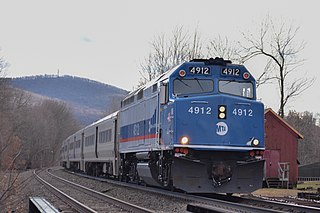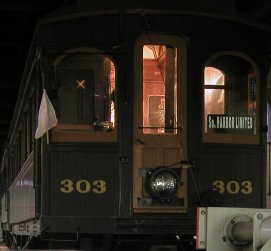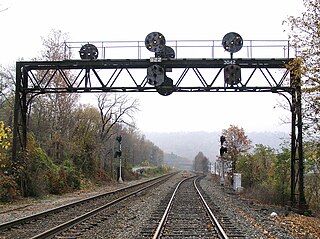Operations
BSOR traffic includes animal feed, fertilizer, propane, lumber, scrap metal, cement, aggregates, brick, and paper. The annual tonnage hauled is 50,046 using 556 carloads per year. Trains operate on demand, typically several times per week.
The company offers services such as car switching, car unloading, and locomotive leasing and servicing. It operates the Buffalo Creek yard in Eden, New York and has locomotive maintenance facilities in Hamburg, New York.
BSOR locomotives are painted green with yellow trim.

The New York Central Railroad was a railroad primarily operating in the Great Lakes and Mid-Atlantic regions of the United States. The railroad primarily connected greater New York and Boston in the east with Chicago and St. Louis in the Midwest, along with the intermediate cities of Albany, Buffalo, Cleveland, Cincinnati, Detroit, Rochester and Syracuse. New York Central was headquartered in New York City's New York Central Building, adjacent to its largest station, Grand Central Terminal.
The Erie Railroad was a railroad that operated in the northeastern United States, originally connecting New York City — more specifically Jersey City, New Jersey, where Erie's Pavonia Terminal, long demolished, used to stand — with Lake Erie, at Dunkirk, New York. It expanded west to Chicago with its 1865 merger with the former Atlantic and Great Western Railroad, also known as the New York, Pennsylvania and Ohio Railroad. Its mainline route proved influential in the development and economic growth of the Southern Tier of New York State, including cities such as Binghamton, Elmira, and Hornell. The Erie Railroad repair shops were located in Hornell and was Hornell's largest employer. Hornell was also where Erie's mainline split into two routes, one northwest to Buffalo and the other west to Chicago.

The Delaware, Lackawanna and Western Railroad was a U.S. Class 1 railroad that connected Buffalo, New York, and Hoboken, New Jersey, a distance of 395 miles (636 km). Incorporated in Pennsylvania in 1853 primarily for the purpose of providing a connection between the anthracite coal fields of Pennsylvania's Coal Region and the large markets for coal in New York City. The railroad gradually expanded both East and West, eventually linking Buffalo with New York City.
The Lehigh Valley Railroad was a railroad built in the Northeastern United States to haul anthracite coal from the Coal Region in Pennsylvania. The railroad was authorized on April 21, 1846 for freight and transportation of passengers, goods, wares, merchandise and minerals in Pennsylvania and the railroad was incorporated and established on September 20, 1847 as the Delaware, Lehigh, Schuylkill and Susquehanna Railroad Company. On January 7, 1853, the railroad's name was changed to Lehigh Valley Railroad. It was sometimes known as the Route of the Black Diamond, named after the anthracite it transported. At the time, anthracite was transported by boat down the Lehigh River. The railroad ended operations in 1976 and merged into Conrail along with several northeastern railroads that same year.

NJ Transit Rail Operations is the rail division of NJ Transit. It operates commuter rail service in New Jersey, with most service centered on transportation to and from New York City, Hoboken, and Newark. NJ Transit also operates rail service in Orange and Rockland counties in New York under contract to Metro-North Railroad. The commuter rail lines saw 29,843,100 riders in 2021, making it the second-busiest commuter railroad in North America as well as the longest by route length. This does not include NJ Transit's light rail operations.
The Lake Shore and Michigan Southern Railway, established in 1833 and sometimes referred to as the Lake Shore, was a major part of the New York Central Railroad's Water Level Route from Buffalo, New York, to Chicago, Illinois, primarily along the south shore of Lake Erie and across northern Indiana. The line's trackage remains a major rail transportation corridor used by Amtrak passenger trains and several freight lines; in 1998, its ownership was split at Cleveland between CSX Transportation to the east and Norfolk Southern Railway in the west.

The Middletown and New Jersey Railroad is one of two railroads in the city of Middletown, New York; the other being its interchange partner, Norfolk Southern Railway. The MNJ consists of 43 miles (69 km) of track in southeastern New York serving Orange County and the Hudson Valley. The railroad also operates and has trackage rights on three additional branch lines totalling 40 miles (64 km) leased from Norfolk Southern in Orange County. It was known as the Middletown and New Jersey Railway until 2009, when East Penn Railroad parent Regional Rail, LLC bought the line through a new subsidiary. In 2015, Regional Rail was in turn acquired by Levine Leichtman Capital Partners ("LLCP").

The Delaware-Lackawanna Railroad is a shortline railroad operating in Northeastern Pennsylvania, especially the Scranton area.

The Port Jervis Line is a predominantly single-track commuter rail line running between Suffern and Port Jervis, in the U.S. state of New York. At Suffern, the line continues south into New Jersey as NJ Transit's Main Line. The line is operated by NJ Transit Rail Operations under a working agreement with Metro-North Railroad (MNRR).

The Reading Blue Mountain and Northern Railroad, sometimes shortened to Reading and Northern Railroad, is a regional railroad in eastern Pennsylvania. Its headquarters is in Port Clinton. The RBMN provides freight service on 300 miles (480 km) of track. Its mainline consists of the Reading Division between Reading and Packerton and the Lehigh Division between Lehighton and Dupont. Its main freight cargo is anthracite coal.

Cleveland has been and continues to be deeply rooted in railroad history.
The Southern Tier Line is a railroad line owned and operated by the Norfolk Southern Railway in the U.S. states of New York and Pennsylvania. A mostly former Erie Railroad line, it is suggested that the line runs from Suffern, New York northwest to Buffalo, New York as it shares trackage with Metro-North Railroad’s Port Jervis Line from Suffern to Port Jervis; NS owns the Suffern to Port Jervis trackage and leases it to Metro-North so it can maintain it for its Port Jervis Line passenger operation. From its east end, NS has trackage rights south on the New Jersey Transit Main and Bergen County Lines to Conrail's North Jersey Shared Assets Area.

The Buffalo Line is a railroad line owned by the Norfolk Southern Railway in the U.S. states of New York and Pennsylvania. The line runs from Buffalo, New York southeast to Rockville, Pennsylvania near Harrisburg, Pennsylvania along a former Pennsylvania Railroad line. Its north end is at Seneca Yard in Buffalo, with no direct access to the Lake Erie district, and its south end is at the Pittsburgh Line at Rockville. The line is operated by the Buffalo and Pittsburgh Railroad between Buffalo and Machias, New York, the Western New York and Pennsylvania Railroad between Machias and Driftwood, Pennsylvania, and the Norfolk Southern Railway between Driftwood and Rockville.

The Buffalo and South Western Railroad was a predecessor of the Erie Railroad that ran 89 miles between Jamestown, NY and Buffalo, NY.

The Western New York and Pennsylvania Railroad is a short-line railroad that operates freight trains in Western New York and Northwest Pennsylvania, United States. The company is controlled by the Livonia, Avon and Lakeville Railroad, with which it does not connect. It started operations in 2001 on the Southern Tier Extension, a former Erie Railroad line between Hornell, NY and Corry, PA, owned by the public Chautauqua, Cattaraugus, Allegany and Steuben Southern Tier Extension Railroad Authority (STERA). Through acquisitions and leases, the line was extended from Corry to Meadville, PA in 2002 and to Oil City, PA in 2006. In 2007, the WNY&P leased and sub-leased portions of the north-south Buffalo Line, a former Pennsylvania Railroad line mostly built by a predecessor of the defunct Western New York and Pennsylvania Railway. The two lines cross at Olean, NY.
The Wheeling and Lake Erie Railway was a Class I railroad mostly within the U.S. state of Ohio. It was leased to the New York, Chicago and St. Louis Railroad in 1949, and merged into the Norfolk and Western Railway in 1988. A new regional railroad reused the Wheeling and Lake Erie Railway name in 1990 when it acquired most of the former W&LE from the N&W.

The Buffalo and Susquehanna Railroad was a railroad company that formerly operated in western and north central Pennsylvania and western New York. It was created in 1893 by the merger and consolidation of several smaller logging railroads. It operated independently until 1929, when a majority of its capital stock was purchased by the Baltimore and Ohio Railroad. At the same time, the B&O also purchased control of the neighboring Buffalo, Rochester, and Pittsburgh Railway. The Baltimore and Ohio officially took over operations of both roads in 1932.
The Ontario Central Railroad is an American class III railroad company operating in Ontario County, New York. As of 2007, the ONCT has been under the ownership of the Finger Lakes Railway which is based in Geneva, New York.
The Cleveland Commercial Railroad (CCR) is a shortline railroad which operates in Cuyahoga County in Ohio in the United States. Founded as a freight-only railroad in 2004, it leases and has trackage rights on lines owned by the Norfolk Southern and the Wheeling and Lake Erie Railway. It also operates an industrial switching railroad at the Port of Cleveland.












